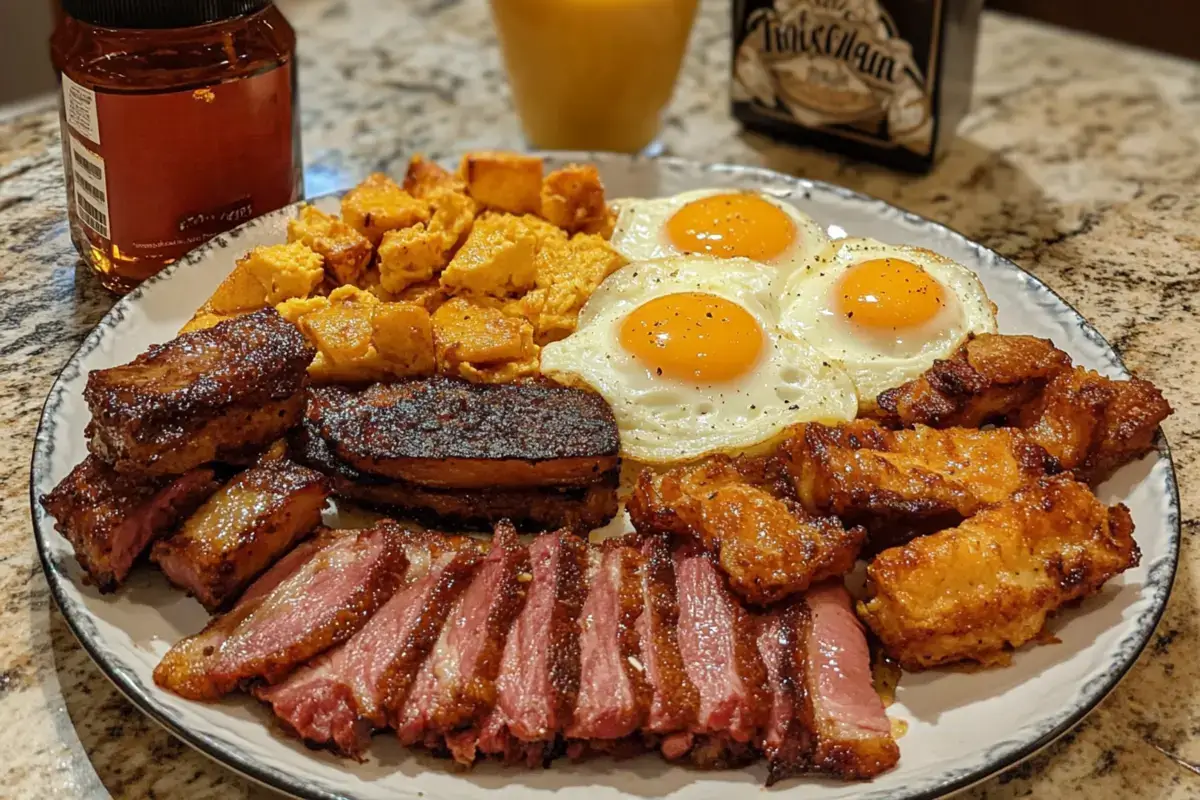Discover the best gluten-free breakfast meats, label tips, and cooking ideas for a satisfying and safe morning meal.
Welcome to a comprehensive look at one of the most pressing dietary questions: What breakfast meat is gluten-free? Today, many people follow gluten-free lifestyles due to health conditions or personal choices. Consequently, finding a safe and nutritious morning protein can be confusing. This article will reveal how to identify gluten-free options, how to cook them without cross-contamination, and how to ensure your kitchen stays celiac-friendly. Additionally, we will explore trusted brands and delicious recipes to help you start your day with confidence. Furthermore, we will discuss the nutritional benefits of these breakfast meats. Altogether, you will be able to fill your plate with tasty and safe proteins.
Understanding Gluten
Gluten is a protein found in wheat, barley, and rye. Indeed, these grains are common in processed foods. Even small amounts of gluten can cause severe reactions for those with celiac disease or gluten sensitivity. Equally important, those who prefer to avoid gluten for dietary or personal reasons must examine their meals carefully.
Breakfast is typically loaded with breads, pancakes, and breakfast meats that may contain hidden gluten. Basically, many processed meats use binders or fillers that derive from wheat flour or other gluten-containing ingredients. Hence, individuals who are sensitive must remain vigilant.
Another issue is cross-contamination, which can occur if gluten-free meats are handled on the same surfaces as gluten-containing foods. For example, a butcher who slices your turkey meat might also slice wheat-breaded chicken cutlets on the same station. Therefore, it is crucial to look for certified gluten-free labeling on meat packages. Consequently, you can enjoy your morning meal with peace of mind. Undoubtedly, understanding how gluten sneaks into foods helps you proactively avoid potential pitfalls.
Why Some Breakfast Meats Contain Gluten ?
Many people assume meat, being naturally gluten-free, is always safe. However, processed meats often include additives or fillers. Meanwhile, these added components can contain wheat-based substances. Basically, manufacturers might use fillers to enhance texture or reduce production costs. Conversely, some producers invest more resources into ensuring their products remain gluten-free.
Often, sausages or meat strips may be coated with flavorings that contain malt or wheat flour. Comparatively, certain ham products use glazes that might incorporate barley malt. Consequently, these hidden ingredients can create issues for individuals who must avoid gluten.
Furthermore, cross-contamination poses another key risk. If a facility processes gluten-containing and gluten-free products using the same machinery, microscopic amounts of gluten could transfer. Particularly when conveyor belts or slicers are not thoroughly cleaned, this contamination risk rises. Therefore, checking brand labeling and certifications is vital.
Hence, before deciding on your morning protein, always inspect the ingredients. Indeed, knowledge is your best defense. If you see terms like “modified food starch” without a specified source, that product could be unsafe. Likewise, hydrolyzed vegetable protein sometimes contains gluten-based ingredients. In short, be cautious and rely on reputable companies. When in doubt, contact the manufacturer for clarity. Eventually, you will find reliable, truly gluten-free breakfast meats.
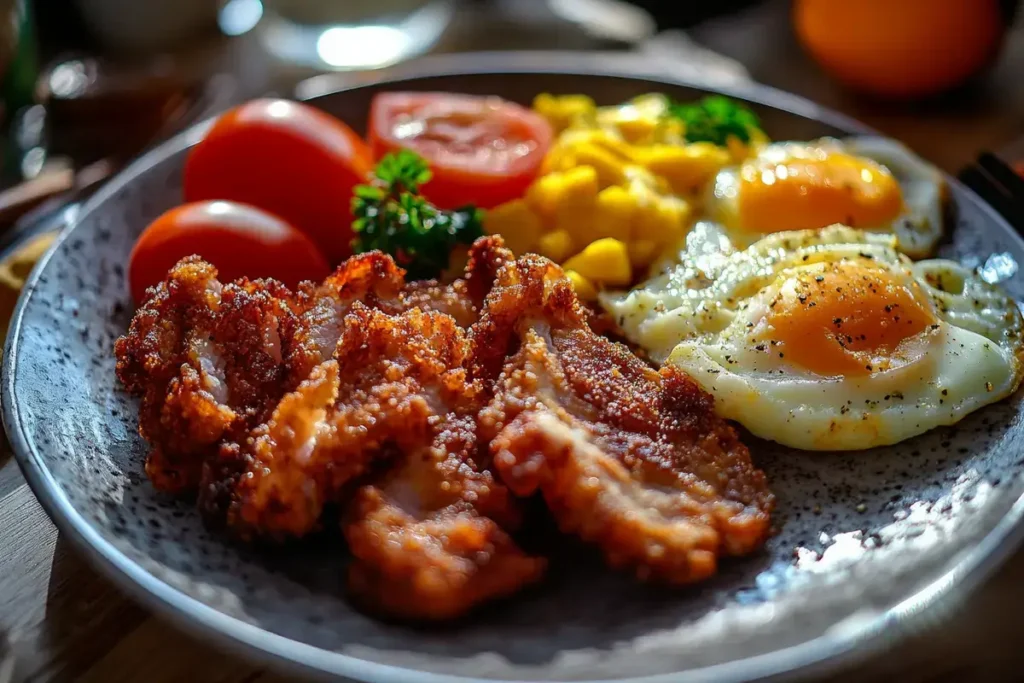
What breakfast meat is gluten-free? An Overview
Many breakfast meats are naturally free of gluten. However, the risk lies in processing. What breakfast meat is gluten-free? is a question that often depends on how the manufacturer handles seasoning, additives, and cross-contamination.
meat is a go-to favorite for countless breakfast enthusiasts. Chiefly, pork belly in its simplest form contains no gluten. Nevertheless, certain brands add spices or sweeteners that might have gluten traces. Therefore, look for clear gluten-free labels or statements on the package.
Similarly, sausage links and patties are delicious. However, they may be problematic if they include breadcrumbs or wheat-based fillers. Comparatively, turkey sausage is often marketed as a lighter alternative but can also feature questionable ingredients. Thus, verifying the label is indispensable.
Ham and Canadian meat are also popular. These cured meats are frequently safe if they do not contain a gluten-containing glaze. Additionally, a wide variety of cold cuts might appear harmless. Nonetheless, hidden gluten can lurk in curing agents. Subsequently, always be sure the product explicitly says “gluten-free.”
Finally, if you are unsure, you can create homemade breakfast meats. Undoubtedly, homemade recipes let you control every ingredient. This approach is also beneficial if you want to experiment with seasonings. Altogether, homemade or carefully labeled products are the safest bet.
Common Sources for Your Kitchen
When you ask, What breakfast meat is gluten-free? you may be overwhelmed by the range of options in the grocery store. Nevertheless, focusing on known gluten-free varieties helps simplify your shopping list.
- meat (Turkey):
Many conventional meat brands are gluten-free. However, always watch for flavored versions like maple or applewood. Occasionally, these can contain barley malt. Turkey meat is a lean alternative, but verify the label to avoid hidden fillers. - Sausages (Pork, Chicken, Turkey, and Vegan):
Sausage can be tricky because recipes vary significantly. Further, some sausages use rusk or breadcrumbs. Look for specialty brands that ensure gluten-free production, or choose a brand bearing a certified GF logo. - Ham and Canadian meat :
These cured meats are good options if no wheat-based glazes are involved. Indeed, reading the ingredients is still essential, particularly for sweet ham. - Other Cured Meats (Salami, Prosciutto):
While typically gluten-free, cross-contamination in facilities remains possible. Consequently, buy from reliable brands that test for gluten. - Homemade Blends:
You can mix ground meats with your own seasoning at home. Accordingly, you have full control over the ingredients. Simply ensure your spices and herbs are gluten-free.
By focusing on these main categories, you can confidently pick proteins that fit your dietary needs.
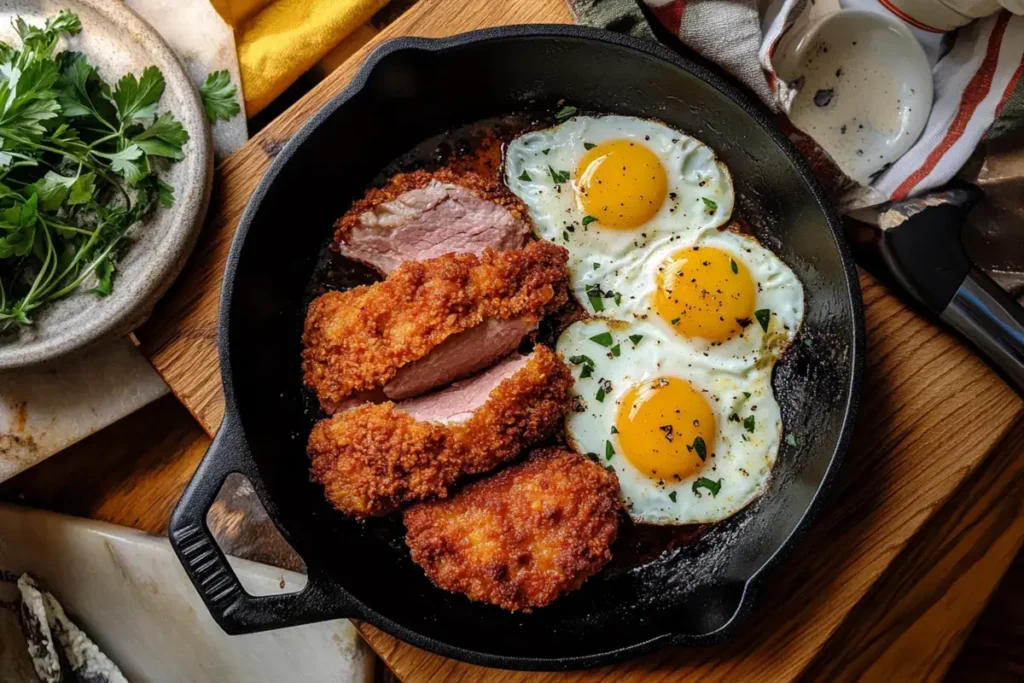
Popular Brands
What breakfast meat is gluten-free? often depends on which brand you choose. Indeed, some producers follow strict protocols, while others do not.
- Applegate Farms:
Known for natural and organic meats, Applegate offers multiple gluten-free breakfast staples. For instance, their meat , ham, and sausages often feature GF labeling. Furthermore, they avoid artificial additives. - Boar’s Head:
Boar’s Head is especially recognized for its deli meats. Generally, they use high-quality cuts. They also highlight gluten-free options and ensure thorough cleaning practices. Additionally, they label clearly, reducing guesswork. - Jones Dairy Farm:
This brand specializes in sausages and meat . Many of their products are labeled gluten-free, and they follow rigorous testing. Moreover, they provide robust product information on their website. - Wellshire Farms:
You might find their breakfast meats in specialty stores. They focus on minimal processing. Equally, they emphasize antibiotic-free meats and offer gluten-free lines. - Niman Ranch:
Although not exclusively gluten-free, some of their products meet GF standards. Checking each product label remains necessary.
Ultimately, checking the packaging or company website is wise. Additionally, if you have doubts, contact the manufacturer. They often provide detailed allergen information. Finally, choose products labeled as “certified gluten-free” whenever possible. This ensures the lowest risk of accidental gluten exposure.
How to Identify What breakfast meat is gluten-free? on Labels
Reading labels is the first line of defense when determining What breakfast meat is gluten-free?. Initially, search for straightforward indicators such as a “gluten-free” statement. Some brands carry certification from organizations like the Gluten-Free Certification Organization (GFCO).
Check the ingredients list thoroughly. Often, gluten hides in fillers, binders, or flavorings. Look for keywords like “wheat,” “barley,” or “rye.” Especially be wary of “modified food starch” unless it specifies a gluten-free source like corn or tapioca. Likewise, “hydrolyzed vegetable protein” might not be safe unless confirmed otherwise.
Consider allergen declarations. Companies often list common allergens, including wheat. If you see a note about potential cross-contact with wheat, the product could be risky.
Be mindful of disclaimers such as “processed in a facility that also processes wheat.” Although not always an immediate red flag, it raises concerns if you are highly sensitive. Eventually, you might reach out to the company for clarification.
Finally, keep a reference guide of known safe brands. This practice can simplify shopping. Consequently, you will spend less time deciphering labels every trip. Altogether, being prepared saves you from unintentional gluten intake. Undoubtedly, knowledge is power when protecting your health.
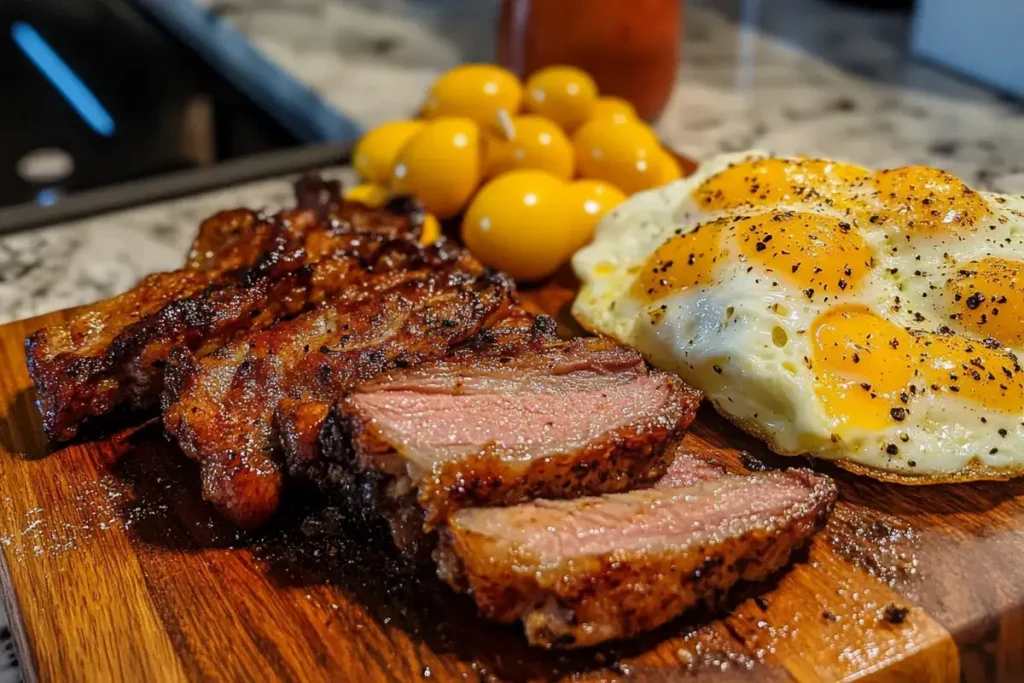
Cooking Safely
When preparing What breakfast meat is gluten-free? at home, safeguard against cross-contamination. Initially, choose separate cutting boards and knives for gluten-free items. If someone in your household prepares wheat toast, keep that bread far from your cooking surface. Another idea is to designate specific pans or utensils for gluten-free cooking.
Pan-Frying:
Use clean, gluten-free oil or butter. Further, confirm that no breaded items were cooked in that skillet beforehand. Consequently, your gluten-free meat or sausage will remain safe.
Oven-Baking:
Line the baking sheet with fresh aluminum foil or parchment paper. This step helps avoid any potential crumbs left behind. Thus, you prevent gluten residue from contaminating your breakfast meats.
Grilling:
Scrub the grill grates thoroughly before use. However, if a marinade containing soy sauce (with wheat) was used previously, be extra cautious. In this case, using a grilling mat can help create a barrier.
Serving:
Plate your gluten-free meats on a separate dish. Moreover, never place them where wheat-based items like bagels or croissants may have rested. Eventually, these precautions become second nature.
By following these tips, you drastically reduce the risk of accidental gluten exposure. Undoubtedly, proper kitchen hygiene is crucial for anyone on a gluten-free diet.
Recipe Ideas
Curious about ways to enjoy What breakfast meat is gluten-free? in your own recipes? Indeed, there are plenty of delicious options. Basically, you can replicate your favorite breakfast dishes without worrying about hidden gluten.
- Homemade Gluten-Free Sausage Patties:
- Combine ground pork or turkey with spices like sage, thyme, salt, and pepper.
- Add a binder like gluten-free breadcrumbs made from rice or corn.
- Shape into patties and cook in a skillet. Consequently, you get fresh, flavorful sausage without questionable additives.
- meat -Wrapped Egg Cups:
- Line a muffin tin with gluten-free meat strips.
- Crack eggs into each cup and sprinkle with cheese (ensure it’s gluten-free).
- Bake until the eggs are set. Altogether, you get a protein-rich meal in a neat package.
- Canadian meat Frittata:
- Sauté diced Canadian meat , onions, and bell peppers.
- Whisk eggs with milk (or a dairy-free alternative).
- Add the mixture to the pan and cook on medium heat. Finish under the broiler. Hence, you have a tasty, versatile dish.
- Vegan Gluten-Free “Sausage” Patties:
- Use a base like lentils or chickpeas, plus gluten-free oats for texture.
- Add plenty of savory seasonings.
- Brown them in a bit of oil. Accordingly, you create a satisfying breakfast for those avoiding meat.
Health Benefits and Nutritional Considerations
Gluten-free breakfast meats can offer several nutritional perks. Firstly, they are often high in protein, which helps keep you fuller for longer. Consequently, you may consume fewer empty carbs. Furthermore, proteins aid in muscle repair and overall energy levels.
Nevertheless, processed meats have downsides. Typically,meat and sausage contain notable amounts of sodium and preservatives. Thus, excessive consumption can raise health concerns. Meanwhile, nitrates and nitrites used in curing may pose risks if ingested in large quantities. Comparatively, choosing brands that minimize additives can reduce these concerns.
Also, consider portion sizes. Even if the meat is gluten-free, moderation is essential. Complement your breakfast meats with nutrient-rich foods like fruits, vegetables, and whole grains (gluten-free variants, of course). Consequently, you build a well-balanced meal.
Undoubtedly, balance and variety matter. Indeed, rotating different proteins, like turkey meat or chicken sausage, can offer a broader range of nutrients. Equally, exploring plant-based breakfast meats—ensuring they are gluten-free—can add fiber and other health benefits.
Ultimately, a gluten-free breakfast doesn’t need to be bland. By balancing protein with vitamins and minerals, you promote better health. Therefore, focus on quality, read labels diligently, and include fresh produce in your morning routine.
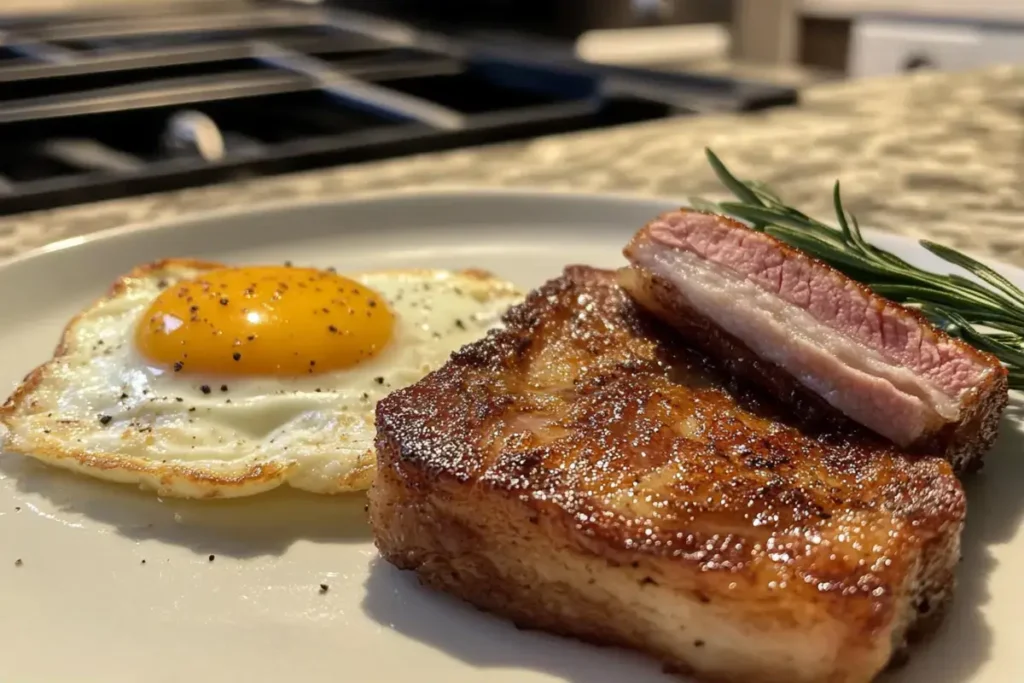
Frequently Asked Questions
Below are some common questions people ask about gluten-free breakfast meats. Read on to find helpful insights that address each concern clearly and succinctly.
What breakfast meats are gluten-free?
Many traditional breakfast meats are naturally gluten-free, including plain pork meat , turkey meat , and unseasoned ham. However, some brands use fillers and flavorings with wheat, barley, or rye. Always check labels for a gluten-free statement. Additionally, seek certified gluten-free products from trusted companies. Moreover, avoid any product that lists “wheat,” “modified food starch” (unspecified source), or “malt” in its ingredients. Consequently, you reduce the risk of hidden gluten sneaking into your meal.
Is Jimmy Dean sausage meat gluten-free?
Jimmy Dean offers several sausage products, yet not all carry a gluten-free label. Some varieties contain wheat-derived fillers. Initially, check their official website or the packaging for the specific product you want. While Jimmy Dean does have some sausage patties labeled as gluten-free, it is essential to confirm ingredient lists, as recipes can change over time. Indeed, contacting the brand directly can also provide the most up-to-date information. Finally, if the package does not explicitly say “gluten-free,” use caution.
What cold meats are gluten-free?
Cold meats, such as deli ham, turkey, salami, and roast beef, can be gluten-free if they do not include wheat-based additives. Many brands, including Boar’s Head, Applegate, and others, highlight which of their products are gluten-free. Nevertheless, cold cuts are frequently produced in facilities that handle various products. Thus, cross-contamination can occur if lines are not cleaned properly. Therefore, always confirm with the brand, ask your deli counter for details, or look for prepackaged meats that have a clear gluten-free label.
Which sausage is gluten-free?
The gluten-free status of sausage varies by manufacturer and ingredients. For instance, Jones Dairy Farm, Applegate, and certain small artisanal brands produce sausage labeled and tested as gluten-free. Initially, focus on companies that clearly list gluten-free on the packaging. Another trick is to make your own sausage at home using ground meats and gluten-free seasonings. Eventually, if you prefer store-bought, compare brand labels and prioritize those with dedicated gluten-free processing lines. In short, verifying each product is key.
By clarifying these concerns, you can confidently decide which meats belong in your gluten-free morning routine. Indeed, knowledge of ingredients and clear labeling is the easiest way to protect your health. Ultimately, always trust your instincts. If a label seems vague or you suspect cross-contamination, consider seeking safer alternatives.
Conclusion
Selecting What breakfast meat is gluten-free? can feel overwhelming. Nonetheless, by reading labels, researching brands, and practicing safe kitchen habits, you can enjoy a satisfying breakfast without the worry. Basically, knowledge is your best tool, especially when it comes to understanding additives and potential cross-contamination. Therefore, always double-check packaging for gluten-free certifications and keep an eye out for hidden wheat-based ingredients.
Gluten-free options include everything from meat and ham to gluten-free sausages and vegan patties. Furthermore, you can create homemade blends if you want complete control over what goes on your plate. Undoubtedly, variety is out there, so never feel limited in your breakfast choices. Altogether, your morning meal can remain both safe and delicious. Ultimately, with careful selection and preparation, a gluten-free breakfast full of flavor is unquestionably within reach. Enjoy exploring new recipes and brands to spice up your mornings.

